People First Impact Method in Ebola & Covid-Response
During the Ebola epidemic in DR Congo, our team employed a people-centred approach in responding to the spread of rumours about the epidemic.
Read more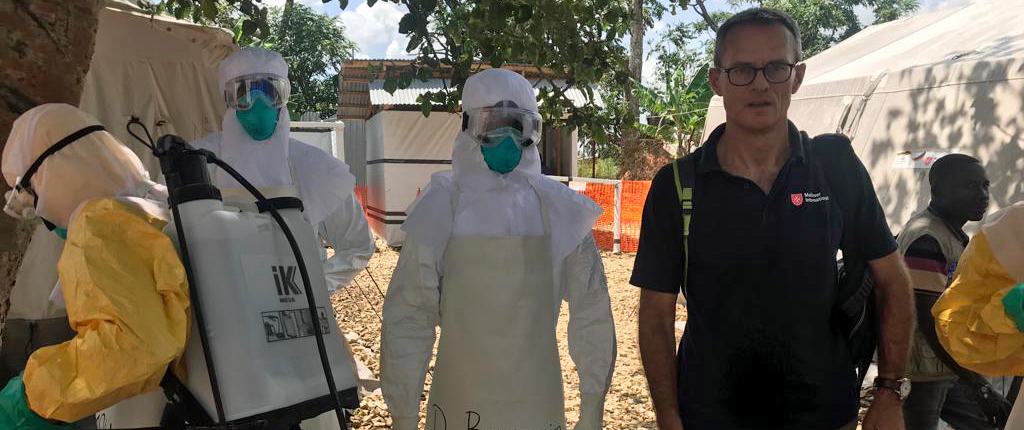
The Ebola virus is one of the most dangerous pathogens in the world. According to the World Health Organisation (WHO), an average of 50 percent of people infected with Ebola die. In the past, the mortality rate has fluctuated between 25 and 90 percent, depending on the type of Ebola virus and the medical conditions.
In the largest outbreak to date in West Africa, approximately 28,000 people were infected with the virus between 2014 and 2016. More than 11,000 died because of the disease. There were also major outbreaks in the Democratic Republic of the Congo between 2018 and 2020. In February 2021, twelve cases of the Ebola virus disease (EVD) were reported in the Congolese province of North Kivu. In May 2021, the Ministry of Health of the DR Congo and WHO announced the outbreak was over. However, the virus remains a constant threat.
Malteser International was active in the countries that are most at risk of an outbreak of Ebola such as Guinea and Liberia over many years and today supports people in the DR Congo in their fight against the disease with education and prevention measures as well as protective equipment and other supplies. Learn more about the symptoms and treatment of the Ebola virus disease and how we are working to contain the disease.
The Ebola virus disease is a rare and life-threatening infectious disease caused by the Ebola virus. Ebola initially manifests itself in flu-like symptoms and in the course of the disease can lead to organ failure or inflammation of the brain and, if left untreated, to death. So far, Ebola virus disease has only occurred in African countries south of the Sahara.
Ebola virus is a genus of the so-called filoviruses and can be divided into five species: Zaire, Sudan, Taï Forest (originally Côte d'ivoire Ebolavirus), Bundibugyo, and Reston. The species are each named after the place where they were first detected. While the first four species are assigned to the highest risk group under the Biosubstances Ordinance due to their high lethality ("deadliness") and risk of infection, Reston virus is the only one of the five species that is harmless to humans. This variant mainly affects pigs and macaques, but does not cause any symptoms of disease in humans.
The Zaire virus is probably the best-known variant of the Ebola virus and also the one generally reffered to when people talk about Ebola. With a lethality rate of 60 to 90%, it is the most dangerous virus in the filovirus family. The species was first identified in 1976 in Zaire (now the Democratic Republic of Congo). During the outbreak, 280 of the 318 infected persons died.
The Sudan virus, which broke out again in Uganda in September 2022, is a severe and often fatal variant of the Ebola virus. Since the species was discovered in 1976, there have been a total of seven outbreaks. The case fatality rate of Sudan virus varied between 41 and 100%. Diagnosis of this variant can sometimes be difficult because in its early stages it resembles other infectious diseases such as malaria or typhoid fever.
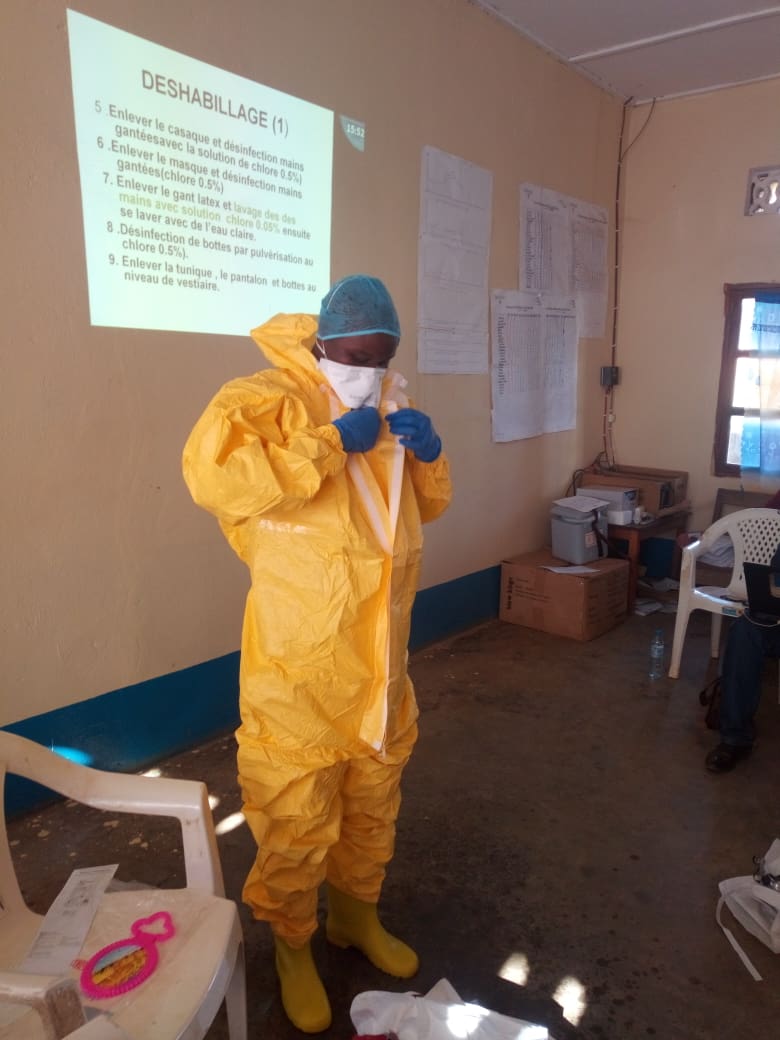
Ebola is transmitted through direct physical contact with a person who is sick with or has died from EVD, especially through blood, saliva, sweat, urine, or other body fluids. Transmission through the air, called aerosol transmission, does not happen with the Ebola virus. An infected person is only considered contagious when the first symptoms appear. The more severe the symptoms are during the course of the disease, the higher the risk of infecting others.
Transmission can also occur through contact with animals. Monkeys, bats, antelopes, and porcupines are among the animal species known to transmit the disease to humans. It is assumed that the virus was introduced into the human population through contact and consumption of infected animals. According to current knowledge, this transmission route is often the cause of epidemics.
For medical staff, doctors and relatives who treat infected persons, there is a particularly high risk of infection if the necessary precautions are not taken. Patients should therefore be strictly isolated and direct physical contact with them avoided. The same applies to objects such as clothing or bed linen that may have come into contact with the body fluids of infected persons. Burials without the recommended hygiene measures can also lead to transmission of the virus through contact with the body of the deceased.
The incubation period of Ebola, i.e. the time period from infection to the appearance of symptoms, is two to 21 days. At first, infected persons suffer from flu-like symptoms such as high fever, physical exhaustion, muscle pain, headache and a sore throat. Stomach pain, vomiting and diarrhoea can also occur within the first three to ten days. In the course of the disease, severe symptoms such as organ failure, internal and external bleeding, respiratory distress and delirium can occur. Many people infected with Ebola die because of organ failure.
In individual cases, long-term damage can occur after the disease has been overcome. Post-Ebola syndrome includes symptoms such as muscle and joint pain, eye diseases and damage to the central nervous system. An international team of researchers led by Mory Keita of the WHO found out in an observational study that Ebola survivors have a 5-fold higher mortality rate up to one year after recovery. The cause of death is difficult to determine due to a lack of long-term studies. Marylyn Addo, a researcher and infectiologist, hypothesised that kidney damage and resulting kidney failure is one of the fatal long-term consequences after contracting Ebola.
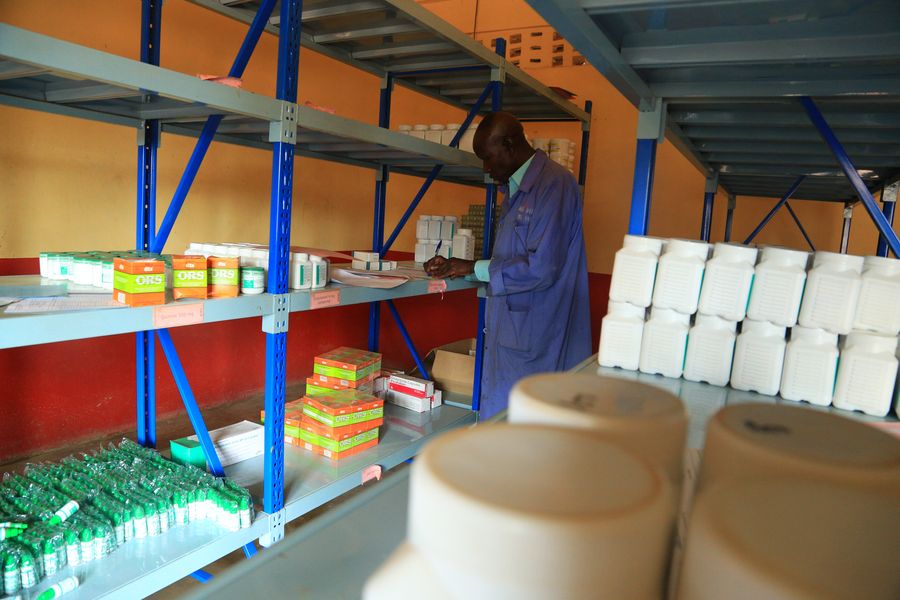
The Ebola virus disease is often difficult to distinguish from other infectious diseases such as malaria, typhoid, or meningitis simply by looking at the symptoms. The symptoms of pregnancy can also resemble Ebola. In order to obtain a definite diagnosis, it is necessary to carry out special diagnostic tests. These include:
However, a focus in the diagnosis of Ebola is placed on the RT-PCR test as well as antigen detection. Antibody detection is not considered reliable, as not all ill patients develop detectable antibodies and cross-reactions with antigens other than those of the Ebola virus may occur. Virus cultivation is practically impossible in the areas affected by the epidemic, as the necessary safety level cannot be maintained.
During the Ebola outbreak in the DR Congo in 2018 to 2020, various experimental therapeutics were used for the first time and evaluated in a study. Two antibody preparations, Inmazeb and Ebanga, were shown to be highly effective against the Zaire Ebola virus. At the end of 2020, the monoclonal antibodies were officially approved by the US Food and Drug Administration (FDA) for the treatment of Ebola virus disease.
In 2019, the Ebola vaccine Ervebo was approved for Europe by the European Commission. In 2020, the vaccine was officially approved by the FDA and qualified by the WHO for use in people over 18 years, excluding pregnant and breastfeeding women. Over 350,000 people have already been vaccinated with Ervebo in Guinea, as well as in the 2018-2020 Ebola outbreaks in the DRC. The vaccine has been available globally since January 2021. In 2020, the 2-component vaccine Zabdeno-and-Mvabea, to be used in people one year and older, was approved for Europe by the European Medicines Agency (EMA).
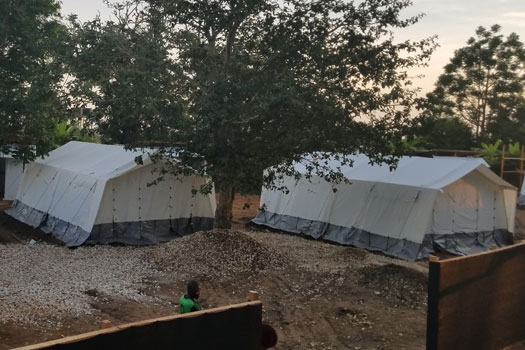
The pharmaceutical company Janssen is working with the WHO to prequalify the vaccine to drive wider access to immunisation in African countries.
In addition to vaccinations, the disease is also treated symptomatically or symptom-relievingly in order to alleviate the course of the disease. Depending on the severity of the disease, the following treatment measures are applied:
On September 20, 2022, Uganda's Ministry of Health Uganda announced an outbreak of the Sudan Ebola virus after the first case was confirmed on September 19 in Mubende district of central Uganda. The rare Sudan species has not been detected globally since its last outbreak in the year 2014 in the Democratic Republic of Congo. In Uganda, it is the first Ebola outbreak since 2012.
Currently (as of November 2022), there are 139 confirmed cases, 55 confirmed death and additional 21 death cases in relation to the outbreak. So far, the Ebola cases were recorded in seven districts in Uganda, whereby Mubende district is most severely affected with more than 50% of confirmed cases.
Countless experts and organization are working to contain the outbreak in Uganda. According to the RKI, experimental vaccines will be used for containment, as there are no approved effective therapeutics for the Sudan variant to date.
Malteser International is also working locally to counteract the outbreak of the deadly infectious disease. With the support of the German Federal Ministry for Economic Cooperation and Development (BMZ), the district of Arua is supported in training its medical and non-medical staff in prevention measures and follow-up. Protective equipment, thermometers, disinfectants and other medical equipment will be provided for the health staff, who will, among other things, measure the body temperature of the people at the border in order to be able to detect further cases at an early stage. Our local partner CAFOMI provides information material on site and organizes training sessions to educate people about the ways in which the virus is contracted.
The largest outbreak of EVD to date (as of June 2021) occurred in West Africa between 2014 and 2016, including primarily in Liberia, Guinea and Sierra Leone, with around 28,000 people falling ill and more than 11,000 deaths. In March 2016, the epidemic was declared over by the WHO. A country is considered free of Ebola if no further Ebola cases occur for a period of 42 days (two maximum incubation periods). However, increased vigilance should be maintained to quickly detect late-occurring Ebola cases and prevent the virus from spreading again.
Between 2018 and 2020, the DR Congo experienced the second most severe Ebola outbreak ever documented in the provinces of North Kivu, Ituri and Sud Kivu. Over a two-year period, the virus spread dramatically, recording over 3,300 cases of illness, of which more than 2,100 were fatal. After the first cases of Ebola also occurred in neighbouring Uganda in June 2019, WHO declared a public health emergency of international concern in July 2019 due to the health risk. The epidemic was only declared over in June 2020 after no new infections could be detected.
In February 2021, there was a new outbreak of Ebola in the DR Congo as well as in Guinea. In the DR Congo, twelve people have been confirmed to have been infected with the virus since the beginning of February 2021, six of whom died. The national Ministry of Health declared the outbreak over on 3 May 2021. This was the twelfth outbreak in the recent history of the DR Congo, which has repeatedly struggled with Ebola and other epidemics.
In Guinea, the virus was detected in a nurse who died at the end of January 2021. Furthermore, a group of visitors to a funeral experienced diarrhoea, vomiting and bleeding symptoms. The Ebola viruswas detected in a total of 23 people, twelve of whom died of the disease. Genetic analyses were able to show that the outbreak apparently goes back to the same viral strain as the Ebola epidemic in 2014 to 2016 in West Africa. Since effective vaccines and medications against the Zaire Ebola virus are now available, measures to contain the virus were more effective in this renewed outbreak of the virus. At the end of February 2021, several thousand people in the vicinity of infected people got vaccinated. As no further cases were reported by the end of the 42-day incubation period, the outbreak in Guinea was declared over on June 19 .
In October 2021, we received the prestigious Else Kröner Fresenius Award for Development Cooperation in Medicine 2021 for our project for improved epidemic prevention and control in the DR Congo. Learn more about the project in the video.
In order to prevent and contain an Ebola outbreak, measures must be taken as quickly as possible to trace the chain of infection and prevent its further spread. For this purpose, it is clarified with whom the affected person had previous contact in order to monitor possibly infected people and to be able to take direct measures in case of an outbreak of symptoms.
Contact persons are also educated about precautionary measures to protect themselves from infection. As soon as Ebola is suspected, the patient is placed in isolation wards or Ebola treatment centres in hospitals. In addition, the further measures are important.
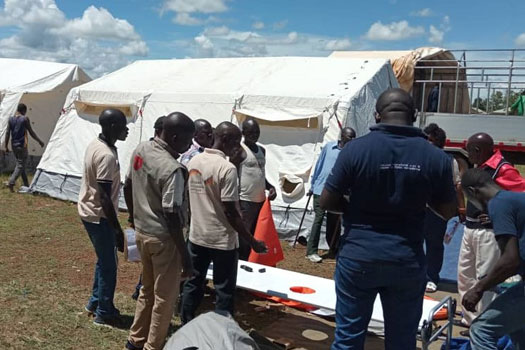
In a study conducted by WHO and the National Research Institute of the Democratic Republic of Congo from August 2018 to March 2019, in which 91,492 first and second contacts of infected people and 28,888 doctors and aid workers were vaccinated, and data were finally collected from 93,965 at-risk patients, the effectiveness of ring vaccination was 97.5 per cent.
The chances of survival of those infected by the disease also increased after vaccination. The ring vaccinations are subsequently highly valued and give hope for an effective containment of Ebola outbreaks.
However, the measures can only be effective if the population is aware of the correct behaviour with infected people and the disease. Educational measures are therefore among the most important long-term preventive measures.
By spreading knowledge about protection against the disease, its symptoms and how to deal with a possible infection, future epidemics can be avoided. Hygiene training, improved access to clean drinking water and the availability of health facilities as well as regulated waste management in villages and health facilities also contribute to reducing the risk of epidemics.
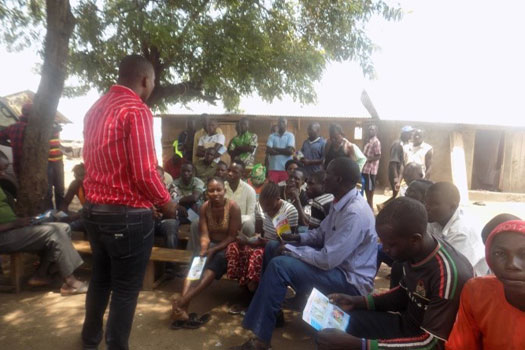
For many years, Malteser International has been active in countries that are most at risk of an outbreak of Ebola to prevent or contain the spread of the virus, including Guinea and Liberia as well as the DR Congo.
Raising awareness of the Ebola virus and educating people about appropriate prevention measures is of utmost importance. During the last devastating Ebola epidemics in Guinea and Liberia, as well as during the more recent outbreaks since 2018 in the DR Congo, we have informed residents about the risks of infection, prevention through personal and food hygiene, and appropriate behaviour in the case of symptoms.
In our community awareness campaigns, we follow a participatory approach: with the so-called People First Impact method (P-FIM), we put the people at the centre of the measures and listen to the communities first. The aim is to understand their understanding of the disease and existing hygiene measures.
This is the only way to reduce possible mistrust and prejudice and to develop effective measures that are supported by the communities. Read more about P-FIM and Ebola in one of our articles. Other measures include interactive radio broadcasts and songs to raise awareness of the disease, door-to-door sensitisation and the distribution of posters and flyers.
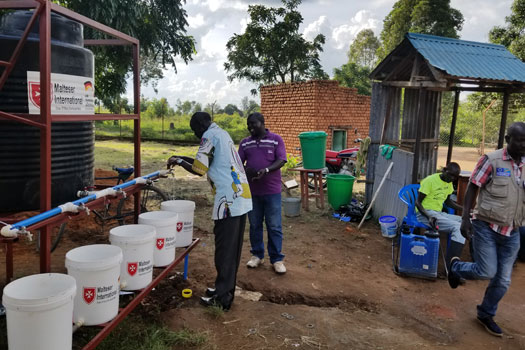
In terms of prevention, we regularly conduct further training for medical staff and set up protective measures in cities threatened by outbreaks in order to prevent infections and to be able to detect first symptoms at an early stage. The training of health staff and national health management teams is fundamental to improve the prevention and control of Ebola and other infectious diseases.
Our holistic approach also includes creating improved water and sanitation facilities and raising awareness of hygiene practices. Furthermore, we are establishing health zones with emergency supplies such as protective equipment, testing materials and medicines that can be used quickly in the event of a new outbreak. An isolation unit is also ready in case of an outbreak. In addition, we supply personal protective equipment and suits to health centres to protect care workers from infection.
The countries threatened by Ebola are in urgent need of further support. With your donation, you can support us in the fight against Ebola. Together, we can succeed in improving medical and hygienic conditions in the affected regions and in advancing information campaigns to raise awareness of Ebola and other infectious diseases as well as their prevention and improve treatment options.
During the Ebola epidemic in DR Congo, our team employed a people-centred approach in responding to the spread of rumours about the epidemic.
Read moreWe have been supporting health facilities, villages, schools
and public institutions in the DRC in epidemic preparedness and
response.
The country’s health system must now fight on two fronts: against Ebola and COVID-19
Read moreThe WHO has declared the Ebola crisis in the
DR of Congo a “public health emergency of
international concern”.

Johannes Schildknecht
+49-(0)221-9822-7229